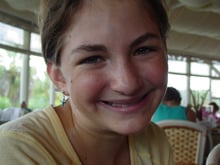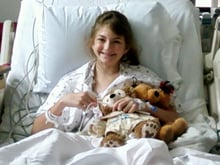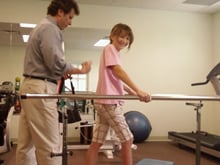|
In response to numerous subscriber requests, information about several Cleveland Clinic Pain Management programs is included herein. Consistent with the treatment of other complex diseases, treating patients for chronic pain requires a comprehensive and multidisciplinary approach.
The following article highlights information on the Pediatric Pain Rehabilitation Program. Cleveland Clinic’s Pain Program is one of the few in the nation that treats children and teens with complex regional
pain syndrome.
Multi-disciplinary Treatments for Children with Complex
Regional Pain Syndrome, CRPS
Marah Miller was lucky to have survived a horrific
head-on car accident. In addition to a few bruises,
she sprained her ankle. But the sprained ankle
never healed. It swelled and turned purple. To
make matters worse, the burning, stabbing pain
intensified to the point where she could only walk
with crutches. Even when her ankle was ever so
lightly touched, the pain was agonizing.
“Marah was taking a bath when a bubble touched
her ankle and it was as if she was being stabbed
by a butcher’s knife,” recalls Marah’s father,
Murray. “That’s how much pain she was in.”
Because of the unrelenting pain, the 13-year-old
Florida girl missed school. She stopped competing
in swim meets, and she couldn’t even visit her
friends without her parents’ supervision. Though
family members and friends were always loving
and supportive of Marah, they grew frustrated and
concerned about her worsening condition despite
months of various treatments by nine different
physicians.
Marah suffers from a classic case of complex
regional pain syndrome (CRPS), formerly known
as reflex sympathetic dystrophy syndrome (RSDS),
a painful nerve disorder usually triggered after
an injury, says Michael Stanton-Hicks, MD,
Department of Pain Management at Cleveland
Clinic. Dr. Stanton-Hicks is one of the world’s
leading CRPS authorities.
“The injury usually occurs in the arms or legs
and the pain does not go away, gets worse and
can spread to other parts of the body,” says
Dr. Stanton-Hicks.
What causes this condition is a mystery. Scientists
are now working on a number of mechanisms
that involve abnormal nerve inflammation in the
affected region and changes in the central nervous
system. These, and other causes are responsible
for the features that are seen such as skin color,
texture, swelling, loss of normal movement,
weakness and alterations in the underlying
structure such as joints, tendons and ligaments.
Up to 7 percent of children develop CRPS after
an injury, and about 8 to 10 percent of injured
adults get the condition following an injury. But
because it is not widely known or understood,
CRPS is often misdiagnosed, and many patients
undergo erroneous or excessive treatments, says
Dr. Stanton-Hicks.
A pain management physician referred the Millers
to Dr. Stanton-Hicks, who led a panel of medical
professionals that developed and launched
Cleveland Clinic’s Pediatric Pain Rehabilitation
Program.
“Because CRPS is so complex and because it
impacts the patients’ lives and their families in so
many different ways, we developed this program
to provide comprehensive treatments across
several medical disciplines,” says Dr. Stanton-
Hicks. “It is one of the few programs in the nation
that offer an interdisciplinary approach to
pain management for children and teens. About
90 percent of patients treated in our program
experience remission of their pain, and about
15 percent of those patients
have relapses.”
After undergoing a thorough evaluation, the
children are treated by a team of physicians,
psychiatrists, psychologists, physical, occupational
and recreational therapists, nurses, dieticians
and social
service professionals.
“Physical therapies seem to be the key for
both adults and children, but with children their
response to physical therapy is very good in
part because of their developmental nature,”
says Dr. Stanton-Hicks. “Psychological counseling
also seems to work very well for children perhaps
because they don’t have the preconceived
inhibitions and attitudes that adults do.”
While most children still need medication to
help them manage their pain, opiates are used
minimally. Instead, corticosteroids, antidepressants,
anti-seizures medications, as well as topical
analgesics have been shown to effectively treat
most CRPS patients. Other treatments may
include sympathetic nerve blocks, intrathecal
drug pumps and spinal cord stimulation. These
treatments, however, are temporary and usually
apply to a small percentage of patients.
Parents also participate in counseling, and children
are required to continue their education during the
two to three weeks of inpatient and outpatient
treatments.
“My daughter went into the program with crutches,
and she walked out of the program on her own
two legs,” says Murray. “It was a very emotional
moment for me and my daughter. We’ll never
forget it.”
Return to Current Issue
| 


 Nagy Mekhail, MD, PhD, Chairman, Pain Management.
Nagy Mekhail, MD, PhD, Chairman, Pain Management.
 Marah is starting to take a few laps in the pool, playing flute in the school band and is thinking about joining the volleyball team.
Marah is starting to take a few laps in the pool, playing flute in the school band and is thinking about joining the volleyball team.
 Michael Stanton-Hick, MD, one of the world’s leading CRPS authorities.
Michael Stanton-Hick, MD, one of the world’s leading CRPS authorities.

 Marah walking without crutches.
Marah walking without crutches.